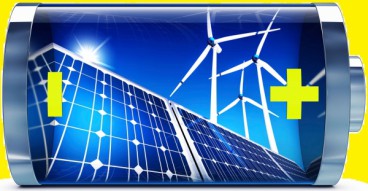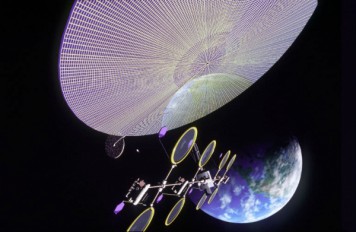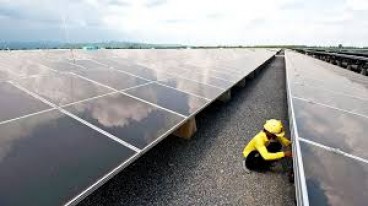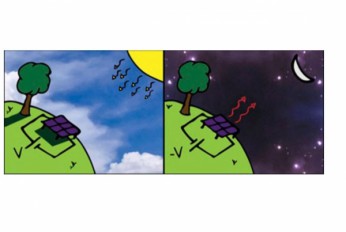New thermochromic windows that function as photovoltaics have been developed

These photovoltaic windows were an accidental discovery at the National Renewable Energy Laboratory (NREL)
These photovoltaic windows were an accidental discovery at the National Renewable Energy Laboratory (NREL)
A window that dynamically responds to sunlight by transforming from transparent to tinted while converting sunlight into electricity is the new, innovative way to capture solar energy. A team of researchers at the U.S. Department of Energy’s National Renewable Energy Laboratory (NREL) recently developed the photovoltaic window while working on finding new ways for homes and buildings to harness more solar power with existing technology. “This was somewhat of an accidental discovery maybe about a year ago,†said Robert Tenent, a member of the team. Their work was published last month in Nature Communications under the title “Switchable Photovoltaic Windows Enabled by Reversible Photothermal Complex Dissociation from Methylammonium Lead Iodide.â€, while the research was funded by the Solar Photochemistry program within the Department of Energy’s Office of Science along with contribution from NREL’s Directed Research & Development program.
Thermochromism
Thermochromic technology has already been used in products such as mood rings, dyes and window tint, but it is the first time that researchers managed to convert the solar energy into electricity (a solar power conversion efficiency of 11.3% has been established according to the researchers). As the window darkens, it generates electricity, while the color change is driven by molecules (methylamine) that are reversibly absorbed into the device. When solar energy heats up the device, the molecules are driven out, and the device is darkened. When the sun is not shining, the device is cooled back down, and the molecules re-absorb into the window device, which then appears transparent. “When the color of the window changed, it was still an active solar cell collecting energy,†said Tenent. “The technology behind this is some of the highest performance solar technology available today.†The prototype allows an average of 68% of light in the visible portion of the solar spectrum to pass through when it’s in a transparent, or bleached, state. When the window changes color—a process that took about 3 minutes of illumination during testing—only 3% is allowed through the window.
Commercialization of the technology and future applications
During a two-month program called Energy I-Corps, the commercialization of the technology has been explored in order to develop viable ways to reach the marketplace. For this reason, Lance Wheeler and Robert Tenent, the program lead for window technology at NREL and co-author on the paper, have also developed a market strategy for a product they called SwitchGlaze. They hope that the technology –although it is still very new and under development, with a still-unknown cost in mass production- will eventually be integrated into vehicles, residential and commercial buildings, and beyond.
Source: NREL news
Source: NREL news
Want to read more like this story?

UK’s first energy-positive office opens in Swansea
Jul, 16, 2018 | NewsThe UK's first energy-positive classroom generates more than one and a half times the solar energy i...

Can glass produce electricity? A Swedish company claims that it can!
Oct, 04, 2017 | NewsThey produce semi-transparent solar panels that can generate solar energy from glass facades, window...

Energy storage could take renewable technology to a whole new level …
Jul, 04, 2016 | NewsStorage systems can make economic sense for renewable energy sources such as wind and solar, accordi...

2016 was a milestone for large-scale solar energy projects in Australia
May, 15, 2017 | NewsWind power has also gained ground in the country as its cost has fallen Wind power has also gaine...

How about space-based solar panels?
Apr, 19, 2018 | NewsThe concept was theorized over half a decade ago, as space-based solar arrays would be illuminated 2...

Thailand’s first large-scale solar power plant has been operating successfully for 4 years now
Jul, 08, 2016 | NewsIt demonstrates the feasibility of large, private sector solar farms, and leads the way to a greener...

World’s-first window blinds that double as solar panels
Jun, 06, 2017 | NewsAn ideal alternative for houses on which the installation of roof solar panels is not feasible An i...

Scientists develop solar panels that can produce energy during the night
Nov, 15, 2019 | NewsScientists from the University of California, Davis, have developed new solar panels that can genera...

2016 will be a Solar-bright Year!
Mar, 21, 2016 | NewsThe solar sector will most likely add more new electricity-generating capacity than any other The...
Trending

Vertical gardens in Mexico City to combat pollution

Characteristics of Load Bearing Masonry Construction

Taipei 101’s impressive tuned mass damper

Dutch greenhouses have revolutionized modern farming

The Line at Neom faces feasibility reassessment while construction continues

The Line at Neom faces feasibility reassessment while construction continues

King Salman Gate unveiled adjacent to Mecca’s Grand Mosque

